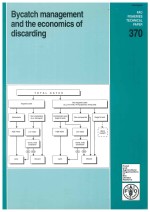
FAO Fisheries Technical Paper. No. 370
Bycatch management and the economics of discarding
by S.Pascoe
University of Portsmouth
United Kingdom
 |
FAO Fisheries Technical Paper. No. 370 Bycatch management and the economics of discardingby S.Pascoe University of Portsmouth United Kingdom |
|
FOOD AND AGRICULTURE ORGANIZATION OF THE UNITED NATIONS Rome, 1997 |
| The designations employed and the presentation of material in this publication do not imply the expression of any opinion whatsoever on the part of the Food and Agriculture Organization of the United Nations concerning the legal status of any country, territory, city or area or of its authorities, or concerning the delimitation of its frontiers or boundaries. |
ISBN 92-5-104043-5
All rights reserved. Reproduction and dissemination of material in this information product for educational or other non-commercial purposes are authorized without any prior written permission from the copyright holders provided the source is fully acknowledged. Reproduction of material in this information product for resale or other commercial purposes is prohibited without written permission of the copyright holders. Applications for such permission should be addressed to the Chief, Electronic Publishing Policy and Support Branch,Communication Division, FAO, Viale delle Terme di Caracalla, 00153 Rome, Italy or by email to [email protected]
© FAO 1997
| Pascoe, S. Bycatch management and the economics of discarding. FAO Fisheries Technical Paper. No. 370. Rome. FAO. 1997. 137p. ABSTRACT The increase in commercial fisheries production over the last 50 years has been accompanied by an increase in the level of incidental catch and discarding of a number of species. Approximately one quarter of the marine commercial catch destined for human consumption is discarded at sea. This has raised the concern of a number of groups in society, including environmentalists, humanitarians and fishers themselves. In this paper, the economic incentives to discard fish are examined. The effects of different managemenet policies on these incentives are also investigated. The concept of an optimal level of discarding is discussed taking into account the externalities that can be created by discarding. Finally, the effectiveness of various measures to reduce the level of discarding is reviewed. these including technical, administrative and economic measures. |
2.1 Definitions and concept3. Fisheries management and the economics of discarding
2.1.1 Bycatch and discards2.2 Magnitude of discarding
2.1.2 Target and bycatch species
2.1.3 Size and sex considerations
2.1.4 Other bycatch/discarding
2.1.5 Fate of targeted and incidental catch
2.2.1 Discards by fishing method and region2.3 Impact of discards
2.2.2 Marine mammals, turtles and seabirds
2.3.1 Environmental impacts of discarding2.4 Chapter summary
2.3.2 Economic impacts of discarding
3.1 Bycatch and technical interactions in an unregulated fishery4. Optimal discarding and externalities
3.2 Discarding of commercial species in an unregulated multispecies fishery
3.2.1 Price related highgrading3.3 Input controls
3.2.2 Capacity related highrading
3.3.1 Limited entry3.4 Output controls
3.3.2 Minimum landing sizes and minimum mesh sizes
3.3.3 Area and seasonal closures
3.3.3 Restrictions on days at sea and other inputs
3.4.1 Trip limits3.4 Chapter summary
3.4.2 Aggregate quota
3.4.3 Individual transferable quotas
4.1 Externalities and discarding5. Management measures to reduce discarding
4.2 Economically optimal levels of discarding
4.3 Estimation of the optimal level of discarding
4.3.1 Two species fishery with non-commercial bycatch4.4 Chapter summary
4.3.2 Two fisheries with different target species
4.3.2 Discards of juvenile target species and gear selectivity
5.1 Technical measures6. Conclusions
5.1.1 Gear selectivity5.2 Administrative measures
5.1.2 Area and seasonal closures
5.1.2 Increased bycatch utilisation
5.2.1 Quota trading5.3 Economic measures
5.2.2 Fixed quota packages
5.2.3 Size specific quotas
5.2.4 Permissible quota over-runs
5.2.5 Recording catch against another's quota
5.2.6 Compulsory landing of all catch
5.2.7 Voluntary surrender of over-quota catch
5.3.1 Taxes and subsidies5.4 Chapter summary
5.3.2 Deemed values
5.3.3 Quota substitution
5.3.4 Value based ITQs
5.3.5 Effort reduction